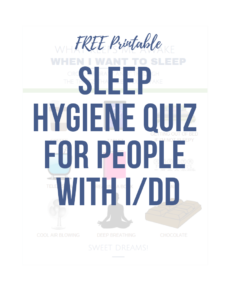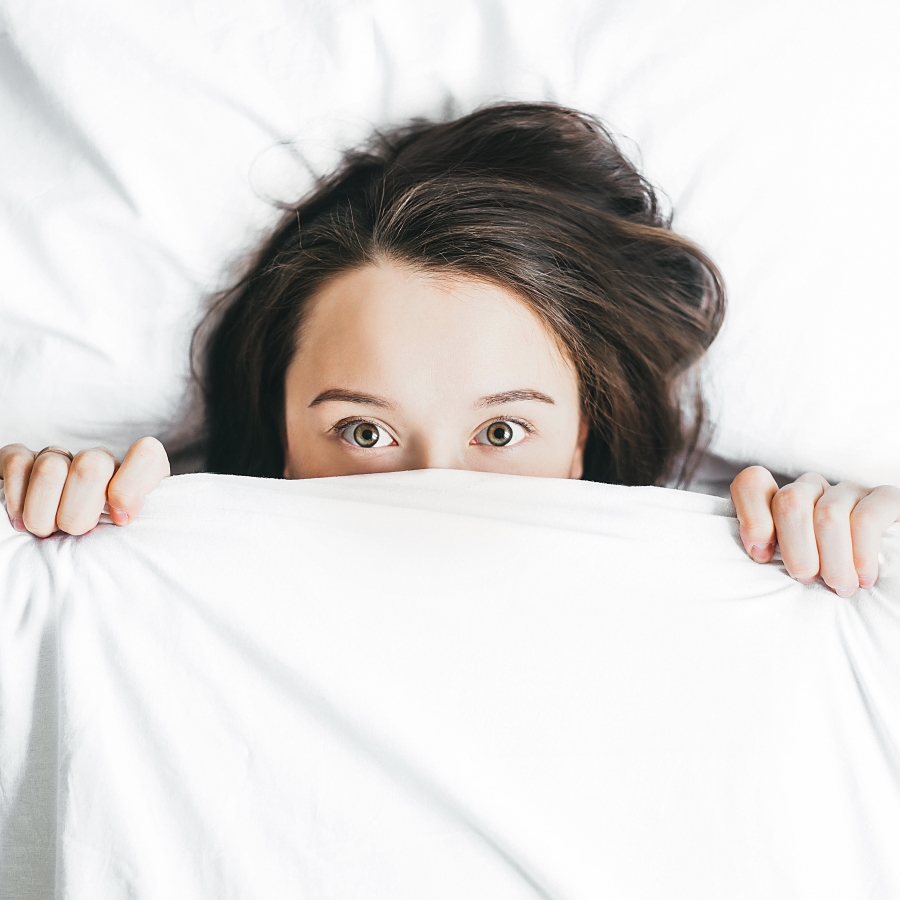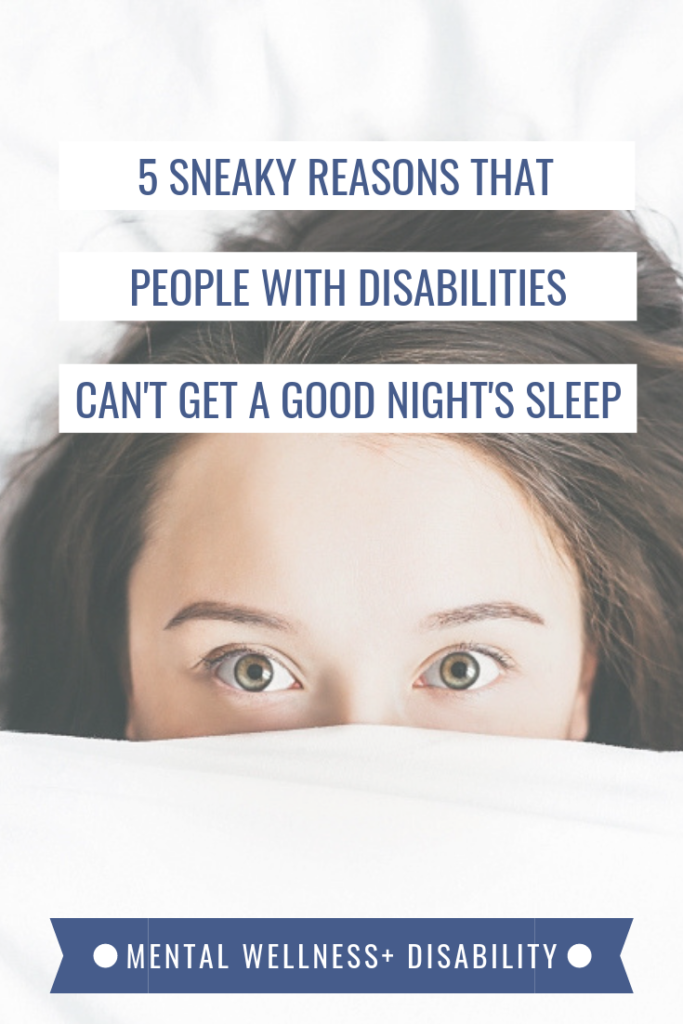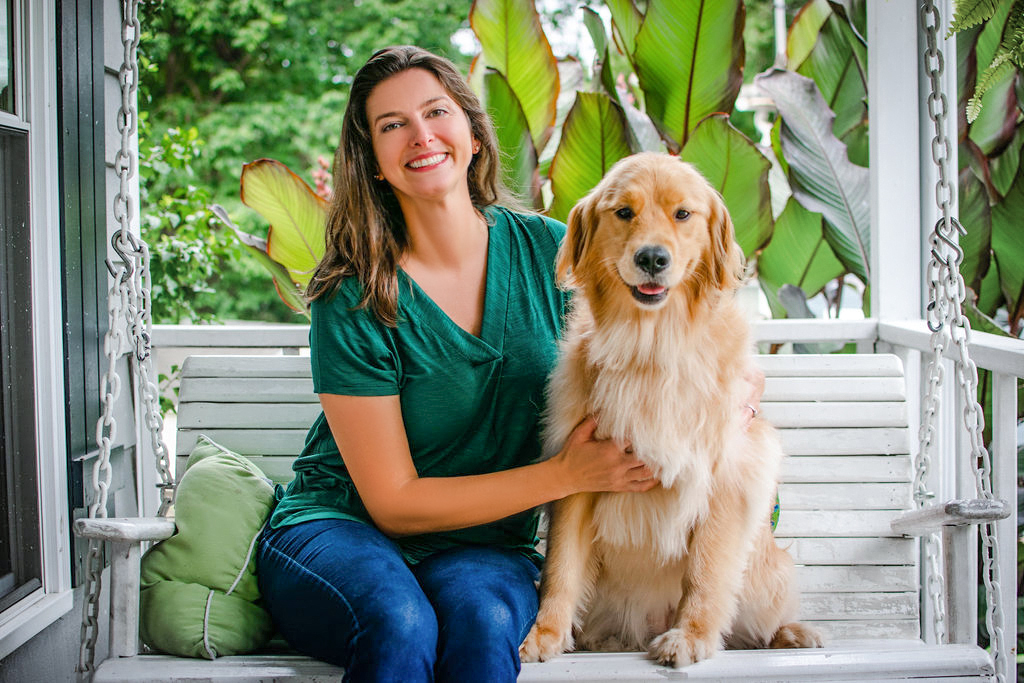A ‘good night’s sleep’ doesn’t look the same for everyone
In this post, I’ll point out some reasons that people with disabilities might not be getting a good night’s sleep. I’ll also discuss sleep hygiene and disabilities. Sleep hygiene is what you do throughout the day and before going to bed that helps you sleep.
But first, it’s important to point out that ‘a good night’s sleep’ can look very different for different people. This can be especially true for people with certain neurological disabilities.
Sleep is a complex neurological function. If a person’s neurological development is not typical, it makes sense that their sleep may not follow ‘typical’ patterns either. This is certainly the case for anyone with:
- Autism
- ADHD
- Epilepsy
- Intellectual Disabilities
- Traumatic Brain Injury
- Cerebral Palsy
- Etc.
I’ve worked with many counseling clients with I/DD who’ve had out of the ordinary sleep needs due to their underlying disability. These needs have included:
- Requiring 14-16 hours of sleep per night
- Functioning better on two blocks of four hours of sleep than on one eight hour block
- Finding 2-3 hours of sleep per night to be fully restorative
- And just about any combination you can imagine in between!
Before trying to ‘fix’ someone’s sleep, consider if their sleep habits are actually a problem
I’m often called for consultation on sleep when someone, say, sleeps 9 hours per night and also takes a daily one hour nap. The person sleeping 10 hours per day is concerning to their parents or paid caregivers.
In talking with the person and their family or staff members, it’ll often become clear that:
- Their daily nap isn’t interfering with their nighttime sleep
- Their nap doesn’t get in the way of their daily activities (work, social life, etc.)
- The extra sleep doesn’t seem to be related to a psychological need (such as sleeping more due to Depression)
- There isn’t an undiagnosed medical concern causing the extra sleep (or they’re not taking a medication that explains the extra sleepiness)
In light of all of this, the extra sleep isn’t a ‘problem’ I’m going to sign on to try to fix. This person has good quality sleep, and good quality of life that isn’t interrupted by their extra sleep. They’re getting more sleep than the average person, but nothing about the sleep is otherwise concerning.
It’s a difference, but not a problem.
When sleep is a problem
Sometimes I’ll get called when a person’s sleep habits or the quality of their sleep has declined to the point that it is a problem. Maybe they’re having trouble falling asleep. Or they’re waking frequently during the night, or they’re waking up from a full night’s sleep not feeling rested.
In these cases it’s worth trying to figure out what might be causing the person to not get a good night’s sleep. This is true whether the change happens quickly or gradually over the course of many months.
There are some common causes of sleep disturbance that can keep anyone from getting a good night’s rest. These include drinking too much caffeine or not getting enough exercise throughout the day, etc.
 This is a worksheet I created for people with intellectual disabilities who want to improve their sleep habits. It’s double sided, with a brief quiz on one side and the answers on the back. Click here to download this printable sleep hygiene quiz for free.
This is a worksheet I created for people with intellectual disabilities who want to improve their sleep habits. It’s double sided, with a brief quiz on one side and the answers on the back. Click here to download this printable sleep hygiene quiz for free.
There are also some common sleep disruptors that are unique to people with certain disabilities. Here are a few things to consider that can have a unique impact on sleep for people with disabilities.
No matter what you think the reason for the sleep disturbance is, do this one thing first
Whenever someone has a dramatic change in their behavior, I almost always recommend that caregivers rule out medical complications before considering anything else. Sleep is one of the rare cases where I don’t.
That’s because there’s one simple thing you can do first. It takes less than a minute and resolves about 50% of sleep concerns. That simple thing is:
Lie in the person’s bed (with their permission, of course!)
- Is the mattress lumpy? Does it smell bad? Or maybe the sheets are itchy and uncomfortable.
- Is there a little light shining in your face from the window, that’s only visible when you’re actually lying in the bed?
- Can you feel the bass of the living room TV thumping the wall behind the headboard?
Often, the source of sleep troubles for people with disabilities is something environmental. They may not recognize or be able to communicate the reason for their sleep troubles.
By lying in the person’s bed yourself, you’ll be able to spot these issues, and get set to work resolving them.
If the source of sleep troubles isn’t so easy to recognize, it’s time to consider other possible reasons that someone with special needs might be having sleep disturbances.
Common Reasons that People with Disabilities Can’t Sleep
Pain
How people with disabilities experience and communicate pain is a complex issue, and is one of my professional passions.
It’s important to always consider how pain may be affecting someone’s behavior. This is true even if they don’t immediately seem to be in pain.
People with disabilities do not often communicate pain in common ways. For example, while most people contort their faces into a grimace when they’re in pain. But people with intellectual disabilities often demonstrate ‘facial freezing’. They actually have less facial expression when they’re in pain. So everyone assumes they’re fine…
The most helpful thing that caregivers can do is to be familiar with the person they’re caring for, and learn how they, individually, express pain
Sleep disturbances in people with disabilities are often due to pain that the person isn’t able to communicate in a way that others understand. Sources of pain range from the common, such as constipation or headache, to the more extreme.
I’ll never forget writing my thesis on pain and disability and bawling my eyes out. I was reading the case study of the death of a healthy, non-verbal man with intellectual disabilities. This man had dramatic changes in his behavior and sleep patterns for a few days before his death. No one thought to take him to the doctor. Had they, they might have realized that he’d swallowed a soda bottle cap. This had perforated his bowel lining, causing him significant pain before ultimately killing him.
I share this story often in workshops and courses that I teach because I hope it strikes a chord with caregivers. A dramatic change in someone’s sleep could be one of the only signs that a person with disabilities gives you that they’re in significant pain. You should always consider that they may be experiencing a medical emergency, and seek appropriate treatment.
Sleep Apnea
Sleep apnea is a sleep disorder in which breathing repeatedly stops and starts during sleep. There are a number of different kinds of sleep apnea. The most common one, especially for people with disabilities, is obstructive sleep apnea. This occurs when the throat muscles periodically relax and block the airway during sleep. Common causes are infections and obesity, both of which are more common in people with developmental disabilities.
Obstructive sleep apnea is especially common people with disabilities like Down syndrome. This is because of the unique physical traits that accompany the disability, such as:
- low muscle tone in the upper airway
- narrowed air passages
- a relatively large tongue
- enlarged tonsils and adenoids
What’s interesting (and frustrating!) about sleep apnea and Down syndrome is this. Most caregivers know that rates of sleep apnea in people with Down syndrome are high – as in very close to 100% high. Yet research has shown that caregivers (including parents) are not very good at recognizing when a person with Down syndrome has sleep apnea. The person with Down syndrome often doesn’t recognize themselves that their sleep is so disturbed. This is why the American Academy of Pediatrics recommends that all kids with Down syndrome have a baseline sleep study conducted by age four.
Even if sleep apnea isn’t obviously the cause of sleep troubles, it’s worth getting a polysomnogram* to be certain.
*fancy medical term for sleep study
Light
So, so many of my clients sleep with a light on! There are usually two reasons why:
- It’s a carryover habit from childhood, when exhausted parents would let them sleep with a light on just to get them to sleep (“Look, I’ll even let you keep the light on so that you can see there’s nothing scary”)
- It’s developed as a habit as disability has progressed. Suppose someone’s having more and more physical difficulty getting to the bathroom in the middle of the night as they age. They’re not going to waste precious time fumbling to find the lamp switch. They’re just going to sleep with the light on in anticipation of their need.
This is problematic, because external light makes our brain think that the sun is shining and that it’s time to wake up. Over time, sleeping with a light on can seriously disrupt our body’s natural sleep rhythms.
One simple fix to both the reasons I mentioned above is to use a touch responsive bedside table lamp, like this one.
Whether someone is waking up fearful of the dark, or if they need to be able to get the light on quickly for medical or personal care reasons, a touch or noise responsive light (yes, I’m talking about the Clapper) can help.
If the person is still struggling to feel comfortable sleeping with the lights off, it may be helpful to seek input from a professional counselor. This professional can help the person make changes to their sleep routines until they become fully accustomed to sleeping with the lights off.
Sleep associations
Many of my counseling clients with disabilities live in group homes, small apartments, or the same bedrooms they’ve lived in since childhood. Because they’re not in a traditional master bedroom, their bedroom furniture is often limited. There’s usually a bed, a dresser with a TV on it, and not much else. Their bedtime routine is usually to lie in bed watching TV or playing a game/browsing the web on a tablet.
The trouble with this is that, over time, their brain starts to associate the bed with being a place for mental activity. When they get in bed, even if they’re physically tired, mentally they have become wired to be active and alert. Their body wants sleep, but their brain is ready to pay attention to a TV show or engage in a game.
The solution, thankfully, is simple. Even in cramped quarters, add a small chair or bean bag. Any TV watching or computer/tablet/phone interaction should happen in the chair and not in bed. Reserve the bed just for sleep, nothing else. This is why it’s often recommended that people get out of bed and do something else if they’re not sleepy. Lying in bed without feeling tired can have a similar effect over time, and can cause sleep disturbances or make them worse.
Televisions, tablets, computers, and phones also give off significant screen light. This can have the same effects on the brain as sleeping with a light on. Most sleep experts recommend shutting off all electronic devices at least one hour before bedtime.
Emotional/psychological factors
Even among mental health professionals, anxiety and other mental health concerns are often overlooked as possible causes of behavioral disturbance in people with developmental disabilities.
Especially for someone who is already experiencing anxiety, one night of bad sleep can cause them to lay awake in bed the next night, anxiously fearing another night of bad sleep. A vicious cycle is born. Getting into bed triggers anxiety and and fears of not sleeping. Over time, the bed becomes the trigger for anxiety about this and other issues.
To break this cycle, I’ll often recommend that the person get out of bed and do a quiet, relaxing, calming activity until they feel tired. Deep breathing, progressive muscle relaxation, or using a Coping Skills Kit are fantastic options to try here. So are yoga, journaling, drawing, reading, doing a puzzle, hand stitching, and so on. The activity should not be exciting, and it should not involve a screen (no TV, tablet, computer, or phone). Once they feel sleepy, they can return to bed.
If you know someone who would benefit from learning about sleep hygiene and disabilities, please share this post!
Keep reading
Other posts you may be interested in
How to Know if Someone is a Real Friend. A Quiz for Teens and Adults with IDD.
In my counseling practice, I offer mental health counseling for teens and adults with IDD. Many of my clients who have Down syndrome, Cerebral palsy, and other disabilities have lots of meaningful friendships in their lives. But sometimes, they ask “how can I know if someone is a real friend?” Maybe you have a friend […]












